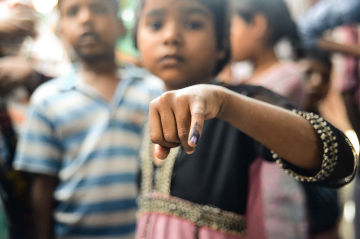New Delhi – On January 13, 2011, it was sunny in Panchla Block in Howrah, West Bengal, temperatures hovering around 70, with a slight breeze. On the crowded streets on this particular Thursday, Rukhsa Khatun, a slight two-year-old with big dark eyes and short cropped black hair, developed a fever. At some point in the previous three weeks, Rukhsa had come into contact with someone else’s feces – perhaps a fly landed on her food, or she drank contaminated water, maybe simply while playing on the street – and unbeknownst to her, she caught a virus.
Once inside her body, the disease quickly spread through her central nervous system, destroying the nerve cells that cause muscle fibers to contract and causing acute flaccid paralysis.
She was lucky; the virus stopped before it reached her lungs, leaving her breathing muscles intact. Ten percent of all paralyzed polio victims are not so fortunate.
To a western audience, polio belongs to the category of vanquished diseases, along with smallpox and diphtheria, that are no longer cause for concern. Iron lungs have been consigned to museums, few remember why Franklin Roosevelt needed a wheelchair. But in India, the fear of polio is still very real. Until 2009, India reported half of all of the world’s cases – more than 700 hundred cases like Rukhsa’s every year.
Nikhat, a stout woman with smile lines around her eyes, is familiar with fear. She’s spent the last two years walking door to door in Moradabad, India, as part of the largest public health initiative ever undertaken. A Muslim who wears the hijab and who lives in the center of India’s last polio epidemic, Nikhat has worked with many worried people – some of whom are more afraid of her then of the disease.
In 2009, after 74 new polio cases broke out in Moradabad, a senior imam, Dr. Mukaffar Sultam Hasam Torabi, explained, “people were still worried about the vaccine. They thought it might be a back-door family planning program.” While parents were anxious to protect their children from polio, using folk remedies like a ritual pre-dawn dunking in a nearby river, many refused to immunize their children, worried that the vaccine contained forbidden animal parts, or caused impotency. When Nikhat came knocking, parents hid their children, or refused to allow her in.
It was in this atmosphere of mistrust and miscommunication that public health officials designed the largest health campaign ever created. Many epidemiologists doubted its chances for success; the worst outbreaks were in neighborhoods which lacked even basic sanitation infrastructure, with migrant populations whose frequent movements made comprehensive coverage difficult to imagine.
But the campaign, a coalition run by India’s national government, WHO, Rotary International, CDC, and UNICEF, spent over $8 billion dollars, employing 2.3 million vaccine administrators armed with only the basic kit of an oral vaccine, color-coded, hand-drawn maps, and penciled-in tally sheets. And it worked:in 2012 India went one full year without any new polio cases. This was a huge milestone. Now, if by early 2014 no new cases are reported, the World Health Organization will certify that polio has been fully eradicated from India.
Of course, as with any public health issue, there are criticisms. Some think the money would have been better spent improving sanitation in a country where 334,000 children die every year because of diarrhea. In the dusty streets of Moradabad, listening to Nikhat explain how some parents used vaccinating their children as a bargaining chip, attempting to demand electricity or basic infrastructure improvements in exchange, the tremendous focus – and the opportunity costs – of the polio campaign appear even more striking. But now that polio is potentially vanquished (doctors involved with the campaign are still
very careful to qualify the achievement) India’s health officials are contemplating how the program’s innovations might be used to improve other health issues, including other routine immunizations.
As for Ruksa, she’s three now, and still learning to walk again; her right foot was twisted and stunted by the disease. But with any luck, she’ll be the last Indian to suffer from polio.

